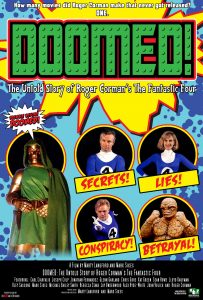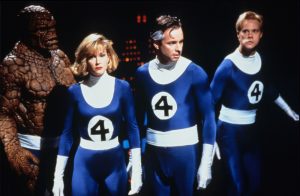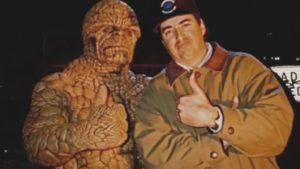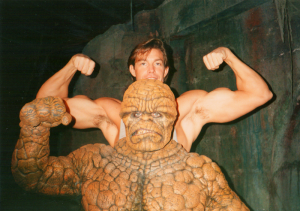
There have been four “Fantastic Four” films, fittingly enough, and I’d argue the best to date has been the first. It is one that has never officially been released, only seeing the light of day via bootlegging. Stan Lee and Avi Arad of Marvel denounce it at every turn and it was, for the longest time, the laughing stock of the comic book cinematic universe. To some, it still is. To others, such as myself, it is the most faithful adaptation to date, albeit hampered by an extremely low budget (just $1 million; table scraps for a production such as this). Where it lacks in special effects and slick production, it makes up for in heart and charm.
I won’t pretend to love the unreleased version of the “Fantastic Four,” but I have a soft spot for it. The same goes for the cast and crew who, despite their limitations hinting towards ulterior motives, truly believed they were making a film intended to be released theatrically. The director, Oley Sassone, was passionate about it, as were the cast that made up the titular heroes. They sensed trouble in the water when the production was rushed from the get-go: casting calls began in the beginning of December 1992 and were finished right after Christmas, and filming wrapped at the end of January 1993. Alas, they all believed this to be the result of a simple Roger Corman production; churn out a film as quickly as possible to reap the benefits. Even Chris Gore, the publicist of Film Threat who had been the only journalist on set since the beginning, believed this to be the case. It didn’t take long for him to put the pieces of the puzzle together and figure out what’s up.

The stench in the air was shady film producers of Constantin Film cranking out a film before their rights to the “Fantastic Four” name expired. They never informed the cast and crew of this reasoning, with Roger Corman possibly also being left in the dark. Marty Langford has compiled stories of the troubled production for his documentary, “Doomed!” And, much like the limitations bestowed upon the film in which he’s documenting, he made the best of his constraints. Big names such as Stan Lee and Avi Arad declined to be interviewed for the documentary and various members of production have since passed. Still, the heavy hitters behind the scenes have all been tracked down and interviewed and are more than happy to share their stories.
Much like John Schnepp’s “The Death of Superman Lives” documentary, Langford’s production is of the talking head variety. It’s not glossy or visually involving, more akin to special features found on a home video release. Whereas Schnepp made up for that with insane stories and (intrusive) directorial commentary, Langford utilizes zippy editing and a cavalcade of footage from the 1994 film to break up the monotony. Schnepp didn’t have the benefit of his troubled production ever being filmed aside from some test footage, while Marty is swimming in a goldmine. On top of access to the “unreleased” film clips, he sprinkles in shots of dailies from the film, glimpses of advertisement and the subsequent Film Threat article, and even archival footage of Stan Lee announcing the film’s release at a 1993 comic book convention. This footage, mixed in with the bubbly interviews, makes for a light, breezy watch.

The documentary isn’t a searing interrogation of the Hollywood production process. Cast and crew lambast the trickery from time to time, but address it as commonplace. While they’re all justifiably upset that their hard work has largely gone unnoticed, they all remain rather chipper and upbeat. Their passion and energy for the movie seeps through in their interviews. At one point, Alex Hyde-Wight, who portrayed Mr. Fantastic, lovingly describes him and the rest of the crew paying for convention tours out of their own product just to get the word out. They didn’t care that they weren’t being reimbursed; they just wanted the world to see their passion project. That level of enthusiasm is infectious!
The narrative is straight-forward: the documentary begins at the acquisition of the “Fantastic Four” rights, transitions into the production of the film, and caps off with the stranglehold on releasing the picture. Interviews and pull-quotes from various articles sprinkle in important details when deemed fit, with the rest being left to theories and hearsay. Some believe the film was to be released, as, if it were made to simply keep the rights, why not make a short film or cut production once the date was met? Others question the fallacy of hiding it in a vault when sufficient money could be made in releasing it now. Whatever the theories may be, they’re all wrapped in a tight, neat little package that is effortlessly engaging.

Simply hearing stories of the production is enough to warrant a viewing. Hearing how quickly they had to edit and utilizing gorilla style filmmaking (such as dressing up a crew member in The Thing costume to roam the streets for extra footage) is fascinating, especially when coupled with the footage. Even anecdotes such as Troma originally being approached to produce the film springs forth quirky thoughts. Could you imagine Lloyd Kaufman helming a “Fantastic Four” film? No doubt he’d want a crossover with the likes of “The Toxic Avenger” and “Sgt. Kabukiman.”
While “Doomed!” may leave a bit to be desired, its zestful demeanor and smorgasbord of information more than makes up for its shortcomings. Would I have liked to seen more interviews from Roger Corman? Certainly, though I suspect his lack of screen time is the result of him not putting much into the production outside of helping produce it. Would it have been fantastic (pardon the pun) to hear from Stan Lee & Avi Arad? Of course, but it’s hard to fault a filmmaker who desperately tried to get in contact with them. All I can do is judge the final product as is and it’s a delightful and insightful glimpse into production Hell!
Final Rating: B+
